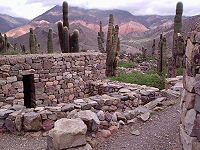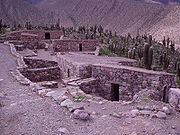
Pucará de Tilcara
Encyclopedia

Pucará
A pucará is a term that refers to the ruins of the fortifications made by the natives of the central Andean cultures and particularly to those of the Inca...
located on a hill just outside the small town of Tilcara
Tilcara
San Francisco de Tilcara is a city in the province of Jujuy, Argentina, and the head town of the Tilcara Department...
, in the Argentine
Argentina
Argentina , officially the Argentine Republic , is the second largest country in South America by land area, after Brazil. It is constituted as a federation of 23 provinces and an autonomous city, Buenos Aires...
province of Jujuy
Jujuy Province
Jujuy is a province of Argentina, located in the extreme northwest of the country, at the borders with Chile and Bolivia. The only neighboring Argentine province is Salta to the east and south.-History:...
. The location was strategically chosen to be easily defensible and to provide good views over a long stretch of the Quebrada de Humahuaca
Quebrada de Humahuaca
The Quebrada de Humahuaca is a narrow mountain valley located in the province of Jujuy in northwest Argentina, north of Buenos Aires . It is about long, oriented north-south, bordered by the Altiplano in the west and north, by the Sub-Andean hills in the east, and by the warm valleys in the...
.
The Pucará de Tilcara was declared a National Monument in 2000. It has been partially rebuilt, and is the only publicly accessible archaeological site in the Quebrada de Humahuaca.
History

At its peak, the pucará covered up to about 15 acres (60,702.9 m²) and housed over 2,000 inhabitants, living in small square stone buildings with low doorways and no windows. Besides living quarters, the pucará contained corrals for animals, sites to perform religious ceremonies and burial sites.
In the late 15th century, the tribes of the Quebrada were finally conquered by the Incas under Tupac Inca Yupanqui
Tupac Inca Yupanqui
Topa Inca Yupanqui , translated as "noble Inca accountant," was the tenth Sapa Inca of the Inca Empire, and fifth of the Hanan dynasty. His father was Pachacuti, and his son was Huayna Capac. Topa Inca belonged to the Qhapaq panaca....
, who used the pucará as a military outpost and to secure the supply of metals such as silver, zinc and copper which were mined nearby.
The Incan domination of the area only lasted for about half a century, and ended with the arrival of the Spanish in 1536, who founded the modern town of Tilcara in 1586.
Rediscovery
In 1908, the ethnographer Juan Bautista AmbrosettiJuan Bautista Ambrosetti
Juan Bautista Ambrosetti was an Argentine archaeologist, ethnographer and naturalist who helped pioneer anthropology in his country.-Life and work:...
of the University of Buenos Aires
University of Buenos Aires
The University of Buenos Aires is the largest university in Argentina and the largest university by enrollment in Latin America. Founded on August 12, 1821 in the city of Buenos Aires, it consists of 13 faculties, 6 hospitals, 10 museums and is linked to 4 high schools: Colegio Nacional de Buenos...
and his student Salvador de Benedetti rediscovered the site and catalogued over 3,000 artifacts during their first three years of digging. Starting in 1911 they began to clear about 2000 square metres (21,527.8 sq ft) and rebuild some of the structures. In 1948 Eduardo Casanova took over and oversaw the opening of the site as an archaeological museum in 1966. Excavation and rebuilding efforts are still governed by the University of Buenos Aires.
Museum
The museum contains 10 rooms, of which three are for temporary exhibitions, a library and administrative offices. The seven permanent rooms display over 5,000 valuable historical pieces from various Indian cultures. Among the most valuable is a mummified body discovered fully clothed in an excellent state of preservation in the Atacama DesertAtacama Desert
The Atacama Desert is a plateau in South America, covering a strip of land on the Pacific coast, west of the Andes mountains. It is, according to NASA, National Geographic and many other publications, the driest desert in the world...
.
- Room 1 is for Argentina and the neighbouring countries of ChileChileChile ,officially the Republic of Chile , is a country in South America occupying a long, narrow coastal strip between the Andes mountains to the east and the Pacific Ocean to the west. It borders Peru to the north, Bolivia to the northeast, Argentina to the east, and the Drake Passage in the far...
and BoliviaBoliviaBolivia officially known as Plurinational State of Bolivia , is a landlocked country in central South America. It is the poorest country in South America...
, and includes inter alia the mummified body from San Pedro de AtacamaSan Pedro de AtacamaSan Pedro de Atacama is a Chilean town and commune in El Loa Province, Antofagasta Region. It is located east of Antofagasta, some 106 km southeast of Calama and the Chuquicamata copper mine, overlooking the Licancabur volcano. It features a significant archeological museum, the R. P...
. - Room 2 deals with the Indian culture of PeruPeruPeru , officially the Republic of Peru , is a country in western South America. It is bordered on the north by Ecuador and Colombia, on the east by Brazil, on the southeast by Bolivia, on the south by Chile, and on the west by the Pacific Ocean....
and displays ceramics of the NazcaNazcaNazca is a system of valleys on the southern coast of Peru, and the name of the region's largest existing town in the Nazca Province. It is also the name applied to the Nazca culture that flourished in the area between 300 BC and AD 800...
, Mochica and Chimú Indians. - Room 3 displays items from the time of the Spanish Conquest.
- Rooms 4 and 5 display items from PunaPunaPuna may refer to:* Puna grassland, a type of grassland in the central part of the high Andes* Puna , the king of Hiti-marama or of Vavau in the Tuamotu legend of Rata* Puna , a type of wind in the Andes...
and Jujuy, including an important reconstruction of a burial ground of the Aymara Indians. - Room 6 displays pieces from the ancient fortification of Pucará de Tilcara itself.
- Room 7 displays further pieces from the Quebrada de Humahuaca.
Botanical garden
A small botanical garden with cactusCactus
A cactus is a member of the plant family Cactaceae. Their distinctive appearance is a result of adaptations to conserve water in dry and/or hot environments. In most species, the stem has evolved to become photosynthetic and succulent, while the leaves have evolved into spines...
species native to the area, located next to the pucará, is also worth visiting.

